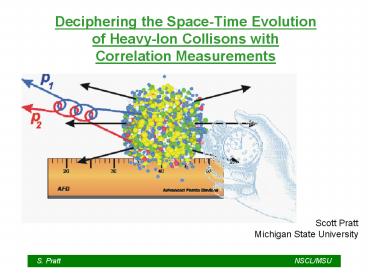S. PrattNSCL/MSU PowerPoint PPT Presentation
Title: S. PrattNSCL/MSU
1
Deciphering the Space-Time Evolution of Heavy-Ion
Collisons with Correlation Measurements
Scott Pratt Michigan State University
2
Hanbury-Brown Twiss Theory
Assume source factorizes,
Fourier transform
cos(qr) for Bosons
_
Probability of two particles of momentum p being
separated by r
_
_
Six dimensions of C(p,q) yield six dimensions of
F(p,r)
3
HBT Theory
_
_
Inverting C(p,q) ? F(p,r)
- Measures probability cloud
- Overall source can be larger
- Inversion depends on f(q,r)2
4
Measuring Lifetime
5
Role of Dynamics Experimental Signatures
Dramatic change in nn correlations _at_ E/A 40
MeV
see also, IMF correlations, Bauge et al, PRL70
(93)
6
RQMD CRABvs. AGS DATA
Microscopic models do surprisingly well at AGS
and SPS
7
RHIC RESULTS
HBT RADII
Thermal Model T 105 MeV, vmax 0.7 Rmax 13
fm, t 10 fm/c
Would have to accelerate tofull speed
instantaneously!
STAR Collab., PRL (2001)
8
?
RHIC RESULTS
- Hydro/Cascade can not fit HBT S. Bass and
A.Dumitru, nucl-th/0012085 D.Teaney, PhD
thesis. P. Kolb, PLB (2001)
D.Teaney, PhD thesis
HYDRO
?
?
?
?
?
?
?
?
Volume too large by factor of 3!
9
THE HBT PUZZLE AT RHIC
- Incorrect Analysis or Interpretation of Results
- Experimental error 2-track resolution, Coulomb
correction - HBT Dogma is wrong 3rd-Body Int., Multi-p
symm., Bjorken geometry
- B. Take Data at Face Value
- EXTREME ACCELERATION, dP/de gt 1/3 ??
- Early disassociation
- Breakup at high phase space density (mp100
MeV) Mass Drops? K.Haglin and S.P., PRC59, 3304
(99) - Thermal Models are misapplied
- Entropy is low by 1.0 per particle Coherent
Stopping? Colored Glass? Gluon Condensate?
10
Balance Functions, a Signal of Late-Stage
HadronizationS. Bass, P. Danielewicz and S.P.
PRL85, 2689 (2000)
Hadronic Scenario
QGP Scenario
- Hadronization _at_ 1 fm/c
- Flux tube and high velocitygradient separate
charges - Y -Y- 1
- Hadronization _at_ 5-10 fm/c
- Most qq pairs created at hadronization
- Y -Y- (T/m)1/2 0.5
_
11
If one knows breakup T,one can determine
s
dh
Difficulty Identifying balancing partners
12
Balance Functions How They Work
For each charge Q, there is one extra balancing
charge Q.
Charges electric, strangeness, baryon number
13
Thermal Model
- Assume Q Q produced at same point.?Dy?
determined only by T and m. - Proton balance functionnarrower that pions.
- Thermal model always narrower than string model.
14
Balance Functions Quantitative Expectations
Hadronic Model pp Balance functions 10
BROADER for AA than for pp due to diffusion.
Proton-antiproton balance functions become
broader due to annihilation.
RQMD, provided by Q.H.Zhang.
- Delayed Hadronization
- Width determined by Breakup T.
- pp Balance functions 20 NARROWER for
Central AA than for pp.
15
Preliminary STAR Results
M. Tonjes, ParkCity, 2001
Identified Pions
More Central Collisions ? Narrower Balance
Functions !!!
16
STAR Summary
QUANTITATIVELY consistent with HIJING ?
Thermal Production in Late Stage
17
Balance Functions To-Do List
- Look at pp collisions.
- Analyze KK- and pp balance functions.
- Measure pt dependence.
- Analyze as functions of Df, Dpt, Qinv.
- Role of transverse collective flow, resonances.
- Quantitatively understand normalization
- Experimental acceptance
- Interplay between acceptance and spectra.
- Loss of partners to other channels, e.g., p
balancing partner could be K-.
All could be accomplished in next 12 months.

